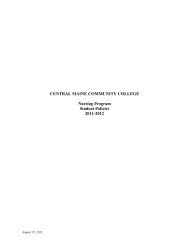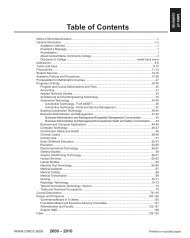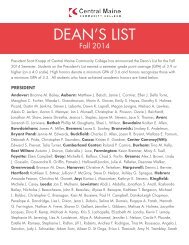Please go to www.cmcc.edu to review the entire Satisfactory ...
Please go to www.cmcc.edu to review the entire Satisfactory ...
Please go to www.cmcc.edu to review the entire Satisfactory ...
You also want an ePaper? Increase the reach of your titles
YUMPU automatically turns print PDFs into web optimized ePapers that Google loves.
Qualitative Standard or grade point average (2.0 CGPA <strong>to</strong> graduate) for maintaining SAP<br />
Grade Point Average: At <strong>the</strong> end of each semester your GPA will be calculated. You will see a term and<br />
cumulative GPA posted on your record. We’ve been posting your GPA status all along and you should be<br />
familiar with this process.<br />
Total Hours Attempted<br />
Cumulative GPA at or above:<br />
1-23* 1.5<br />
24-35 1.75<br />
36-47 1.9<br />
48 and above 2.0<br />
* A student completing <strong>the</strong> first semester of <strong>the</strong> first year must earn a GPA of .70 or higher or he/she<br />
will be au<strong>to</strong>matically suspended.<br />
EXAMPLE: Bill has been attending CM as a part time student for two years. He just completed 30 credit<br />
hours with a CGPA of a 1.8. Although Bill has less than a 2.0 he is still making SAP. However, if his CGPA<br />
doesn’t improve by <strong>the</strong> time he completes 36 hours, he’ll no longer be making SAP in reference <strong>to</strong> <strong>the</strong><br />
Qualitative Standard of 1.9.<br />
Quantitative Standards Policy<br />
Progress in a Program: This may be a new measure for some of you particularly if you have not received<br />
financial aid. There are two parts <strong>to</strong> this component. The first is a 150% rule and <strong>the</strong> second is 67%<br />
semester completion rule. Rule one, (150%) simply stated, says that if your degree requires 60 credits <strong>to</strong><br />
complete, you have 90 credits <strong>to</strong> get <strong>the</strong> job done. Point: Think of <strong>the</strong> 150% rule as a safety net for<br />
students. It allows students <strong>to</strong> repeat courses, enroll in prepara<strong>to</strong>ry or developmental courses, or<br />
withdrawal from a course when necessary.<br />
EXAMPLE: If a certificate requires 30 credit hours, a student has 45 credit hours (150%) in which <strong>the</strong>y<br />
must complete <strong>the</strong> requirements.<br />
If an associate degree requires 60 credit hours, a student has 90 credit hours <strong>to</strong> complete <strong>the</strong><br />
requirements.<br />
If an associate degree requires 72 credit hours, a student has 102 credit hours <strong>to</strong> complete <strong>the</strong><br />
requirements.<br />
Rule two (67%) ensures you can complete your program within <strong>the</strong> 150% time frame. We will take a<br />
snapshot of your progress after each spring semester. Basically we will divide credits earned<br />
(successfully passed) by credits attempted (<strong>the</strong> <strong>to</strong>tal number of enrolled credits after drop/add period)<br />
<strong>to</strong> determine if you are on track <strong>to</strong> graduate in a timely fashion and keep in check mounting financial<br />
debt obligations. We selected <strong>the</strong> 67% marker since it allows students <strong>to</strong> shift between part time and<br />
full time status without penalty.<br />
Example: After Millie’s first year she had attempted 32 credit hours. She only earned 21 hours with a<br />
CGPA of 1.75. While she has met SAP Qualitative Standard, she has NOT met SAP Quantitative Standard<br />
since<br />
21 earned hours divided by 32 attempted hours = 65%, less than <strong>the</strong> required 67%.<br />
Millie would be placed on probation.












